Unit 1 We love Nature Lesson 3 知识汇总(单词+句型+语法)
文档属性
| 名称 | Unit 1 We love Nature Lesson 3 知识汇总(单词+句型+语法) | 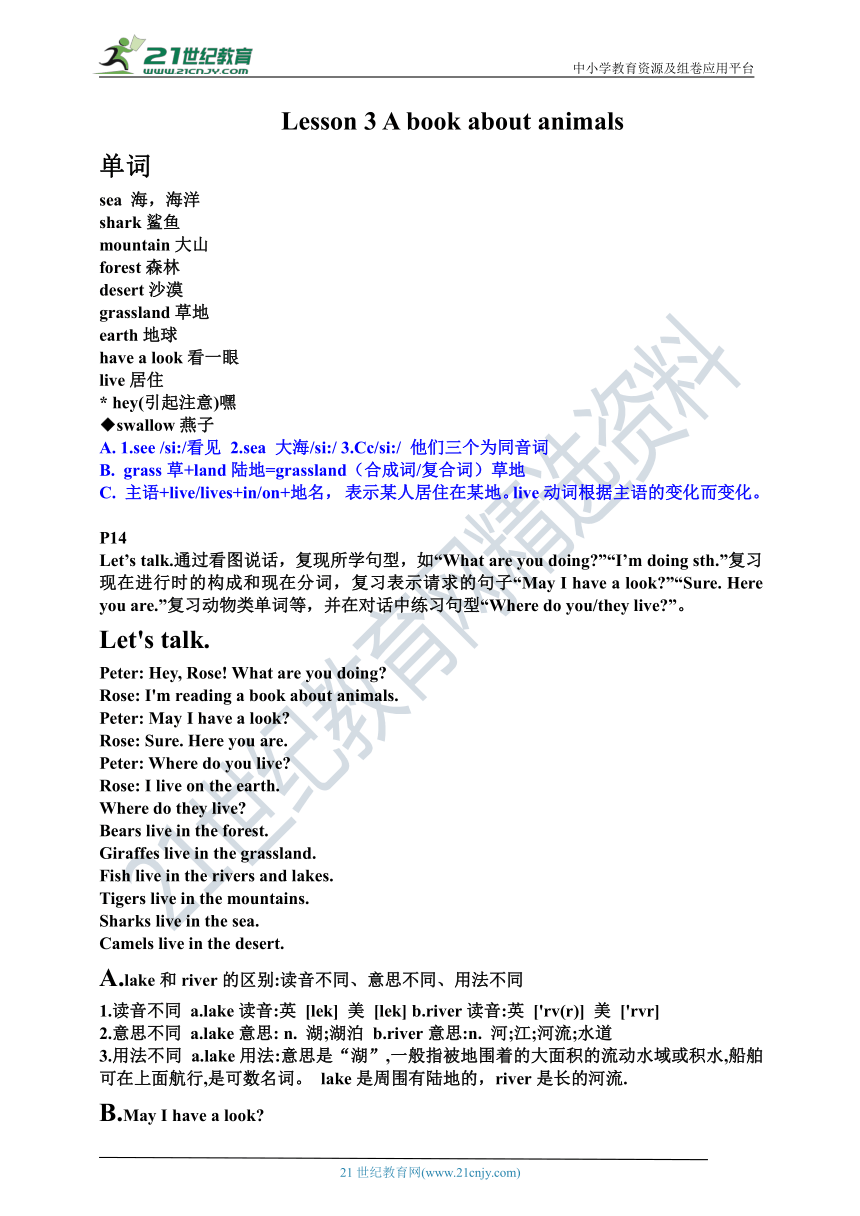 | |
| 格式 | zip | ||
| 文件大小 | 203.5KB | ||
| 资源类型 | 试卷 | ||
| 版本资源 | 川教版 | ||
| 科目 | 英语 | ||
| 更新时间 | 2020-02-25 10:06:25 | ||
图片预览

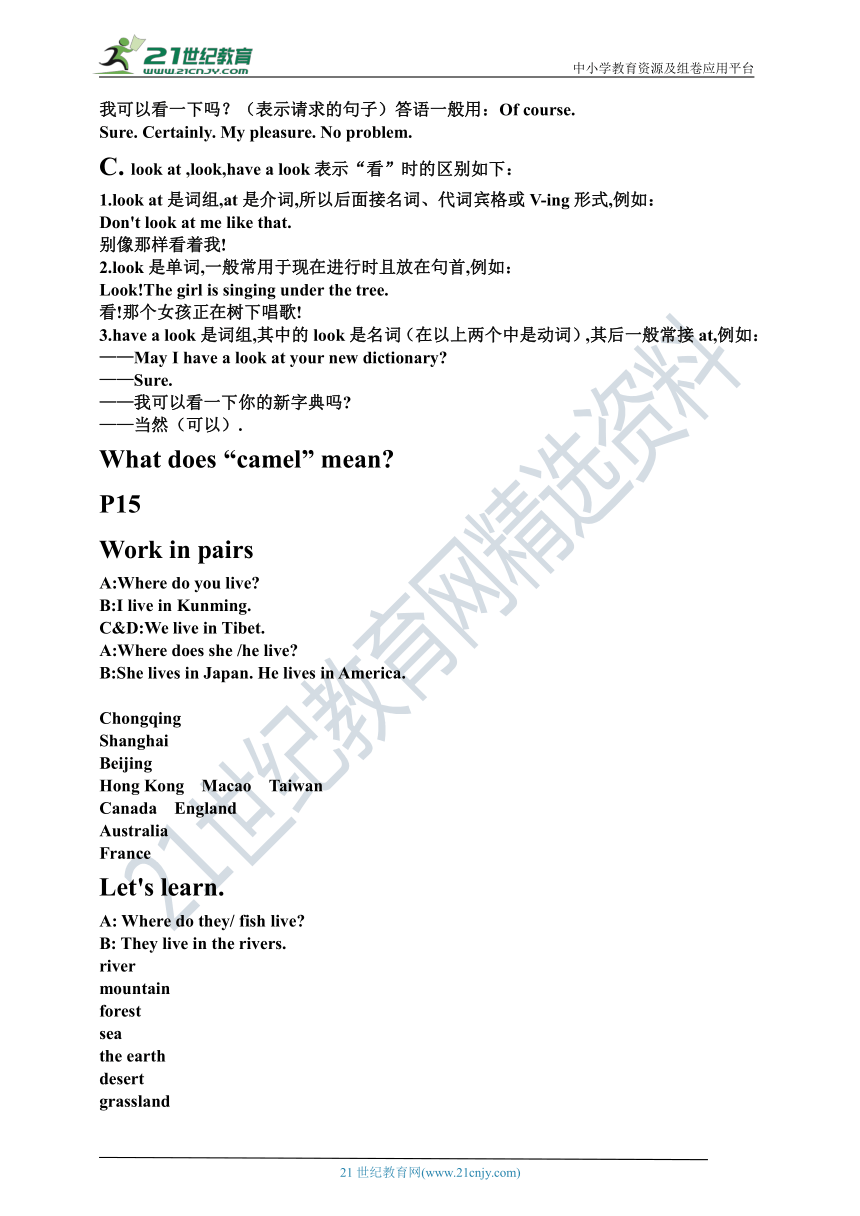
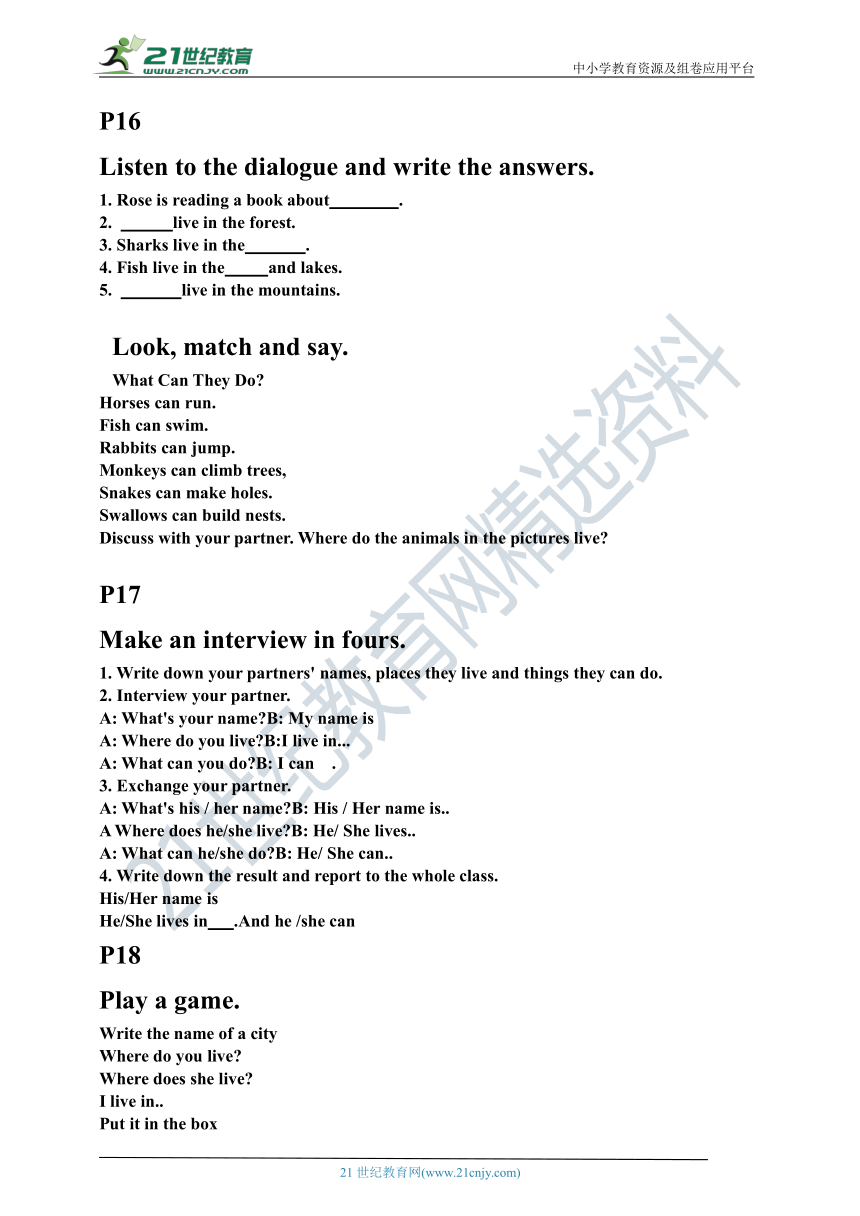
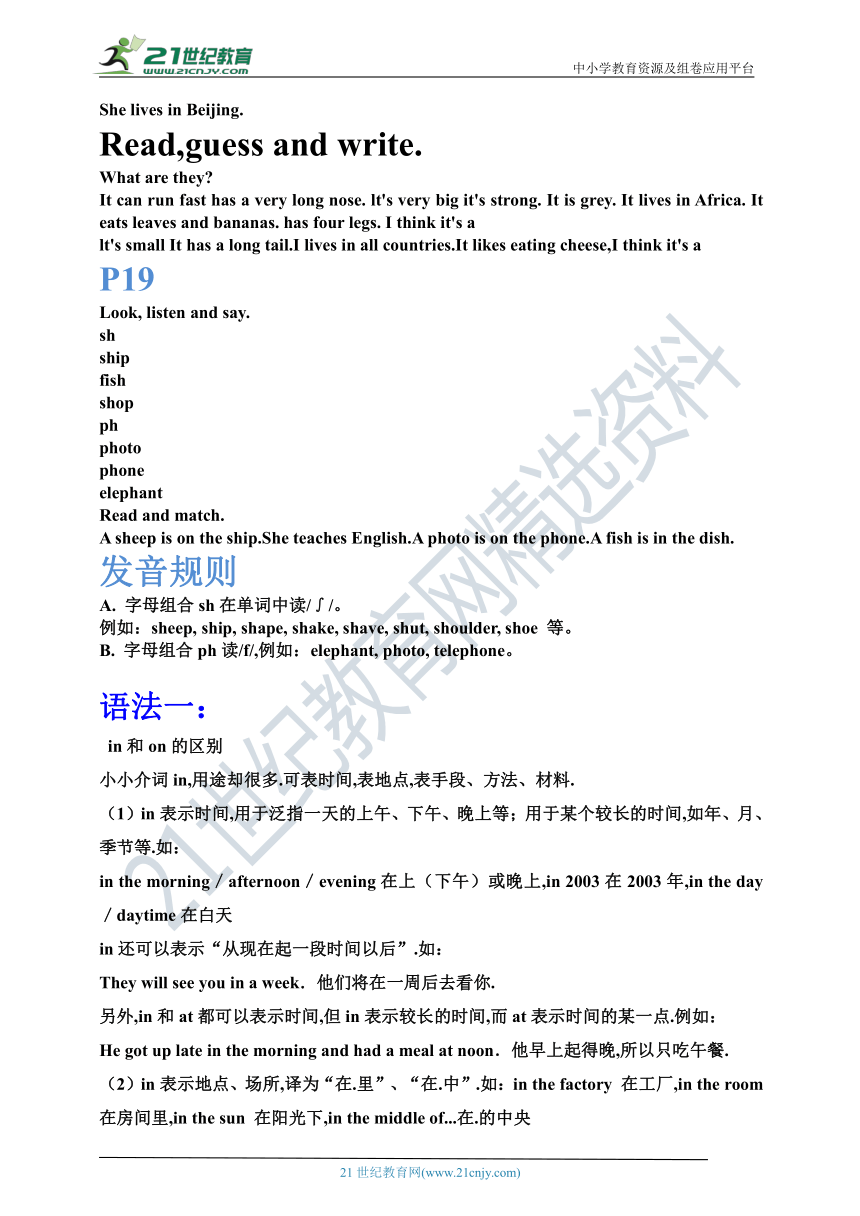
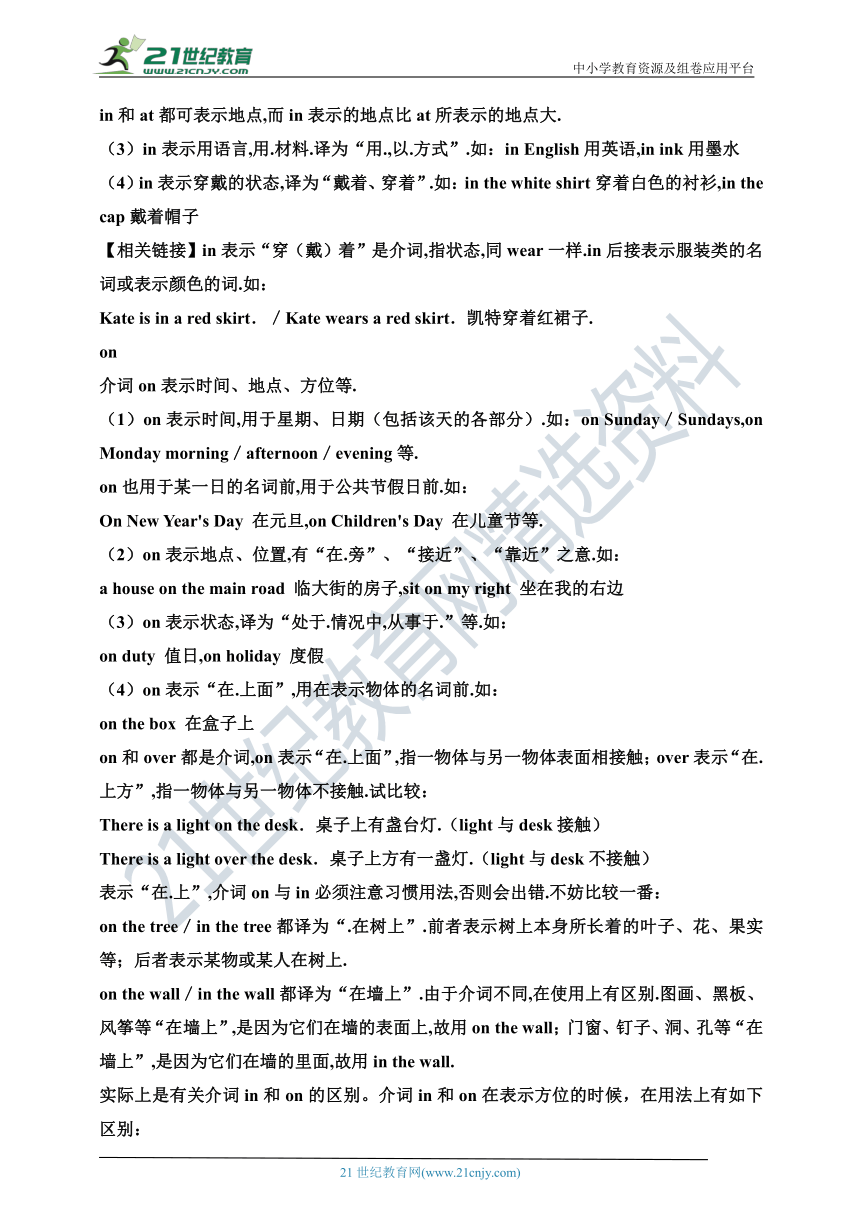
文档简介
中小学教育资源及组卷应用平台
Lesson 3 A book about animals
单词
sea 海,海洋
shark鲨鱼
mountain大山
forest森林
desert沙漠
grassland草地
earth地球
have?a?look看一眼
live居住
*?hey(引起注意)嘿
◆swallow燕子
A. 1.see /si:/看见 2.sea 大海/si:/ 3.Cc/si:/ 他们三个为同音词
grass草+land陆地=grassland(合成词/复合词)草地
主语+live/lives+in/on+地名, 表示某人居住在某地。live动词根据主语的变化而变化。
P14
Let’s talk.通过看图说话,复现所学句型,如“What are you doing?”“I’m doing sth.”复习现在进行时的构成和现在分词,复习表示请求的句子“May I have a look?”“Sure. Here you are.”复习动物类单词等,并在对话中练习句型“Where do you/they live?”。
Let's talk.
Peter: Hey, Rose! What are you doing?
Rose: I'm reading a book about animals.
Peter: May I have a look?
Rose: Sure. Here you are.
Peter: Where do you live?
Rose: I live on the earth.
Where do they live?
Bears live in the forest.
Giraffes live in the grassland.
Fish live in the rivers and lakes.
Tigers live in the mountains.
Sharks live in the sea.
Camels live in the desert.
A.lake和river的区别:读音不同、意思不同、用法不同
1.读音不同 a.lake读音:英 [lek] 美 [lek] b.river读音:英 ['rv(r)] 美 ['rvr]
2.意思不同 a.lake意思: n. 湖;湖泊 b.river意思:n. 河;江;河流;水道
3.用法不同 a.lake用法:意思是“湖”,一般指被地围着的大面积的流动水域或积水,船舶可在上面航行,是可数名词。 lake是周围有陆地的,river是长的河流.
B.May I have a look?
我可以看一下吗?(表示请求的句子)答语一般用:Of course.
Sure. Certainly. My pleasure. No problem.
C. look at ,look,have a look表示“看”时的区别如下:
1.look at是词组,at是介词,所以后面接名词、代词宾格或V-ing形式,例如:
Don't look at me like that.
别像那样看着我!
2.look是单词,一般常用于现在进行时且放在句首,例如:
Look!The girl is singing under the tree.
看!那个女孩正在树下唱歌!
3.have a look是词组,其中的look是名词(在以上两个中是动词),其后一般常接at,例如:
——May I have a look at your new dictionary?
——Sure.
——我可以看一下你的新字典吗?
——当然(可以).
What does “camel” mean?
P15
Work in pairs
A:Where do you live?
B:I live in Kunming.
C&D:We live in Tibet.
A:Where does she /he live?
B:She lives in Japan. He lives in America.
Chongqing
Shanghai
Beijing
Hong Kong Macao Taiwan
Canada England
Australia
France
Let's learn.
A: Where do they/ fish live?
B: They live in the rivers.
river
mountain
forest
sea
the earth
desert
grassland
P16
Listen to the dialogue and write the answers.
1. Rose is reading a book about .
2. live in the forest.
3. Sharks live in the .
4. Fish live in the and lakes.
5. live in the mountains.
Look, match and say.
What Can They Do?
Horses can run.
Fish can swim.
Rabbits can jump.
Monkeys can climb trees,
Snakes can make holes.
Swallows can build nests.
Discuss with your partner. Where do the animals in the pictures live?
P17
Make an interview in fours.
1. Write down your partners' names, places they live and things they can do.
2. Interview your partner.
A: What's your name?B: My name is
A: Where do you live?B:I live in...
A: What can you do?B: I can .
3. Exchange your partner.
A: What's his / her name?B: His / Her name is..
A Where does he/she live?B: He/ She lives..
A: What can he/she do?B: He/ She can..
4. Write down the result and report to the whole class.
His/Her name is
He/She lives in .And he /she can
P18
Play a game.
Write the name of a city
Where do you live?
Where does she live?
I live in..
Put it in the box
She lives in Beijing.
Read,guess and write.
What are they?
It can run fast has a very long nose. lt's very big it's strong. It is grey. It lives in Africa. It eats leaves and bananas. has four legs. I think it's a
lt's small It has a long tail.I lives in all countries.It likes eating cheese,I think it's a
P19
Look, listen and say.
sh
ship
fish
shop
ph
photo
phone
elephant
Read and match.
A sheep is on the ship.She teaches English.A photo is on the phone.A fish is in the dish.
发音规则
字母组合sh在单词中读/∫/。
例如:sheep, ship, shape, shake, shave, shut, shoulder, shoe 等。
字母组合ph读/f/,例如:elephant, photo, telephone。
语法一:
in和on的区别
小小介词in,用途却很多.可表时间,表地点,表手段、方法、材料.
(1)in表示时间,用于泛指一天的上午、下午、晚上等;用于某个较长的时间,如年、月、季节等.如:
in the morning/afternoon/evening在上(下午)或晚上,in 2003在2003年,in the day/daytime在白天
in还可以表示“从现在起一段时间以后”.如:
They will see you in a week.他们将在一周后去看你.
另外,in和at都可以表示时间,但in表示较长的时间,而at表示时间的某一点.例如:
He got up late in the morning and had a meal at noon.他早上起得晚,所以只吃午餐.
(2)in表示地点、场所,译为“在.里”、“在.中”.如:in the factory 在工厂,in the room 在房间里,in the sun 在阳光下,in the middle of...在.的中央
in和at都可表示地点,而in表示的地点比at所表示的地点大.
(3)in表示用语言,用.材料.译为“用.,以.方式”.如:in English用英语,in ink用墨水
(4)in表示穿戴的状态,译为“戴着、穿着”.如:in the white shirt穿着白色的衬衫,in the cap戴着帽子
【相关链接】in表示“穿(戴)着”是介词,指状态,同wear一样.in后接表示服装类的名词或表示颜色的词.如:
Kate is in a red skirt./Kate wears a red skirt.凯特穿着红裙子.
on
介词on表示时间、地点、方位等.
(1)on表示时间,用于星期、日期(包括该天的各部分).如:on Sunday/Sundays,on Monday morning/afternoon/evening等.
on也用于某一日的名词前,用于公共节假日前.如:
On New Year's Day 在元旦,on Children's Day 在儿童节等.
(2)on表示地点、位置,有“在.旁”、“接近”、“靠近”之意.如:
a house on the main road 临大街的房子,sit on my right 坐在我的右边
(3)on表示状态,译为“处于.情况中,从事于.”等.如:
on duty 值日,on holiday 度假
(4)on表示“在.上面”,用在表示物体的名词前.如:
on the box 在盒子上
on和over都是介词,on表示“在.上面”,指一物体与另一物体表面相接触;over表示“在.上方”,指一物体与另一物体不接触.试比较:
There is a light on the desk.桌子上有盏台灯.(light与desk接触)
There is a light over the desk.桌子上方有一盏灯.(light与desk不接触)
表示“在.上”,介词on与in必须注意习惯用法,否则会出错.不妨比较一番:
on the tree/in the tree都译为“.在树上”.前者表示树上本身所长着的叶子、花、果实等;后者表示某物或某人在树上.
on the wall/in the wall都译为“在墙上”.由于介词不同,在使用上有区别.图画、黑板、风筝等“在墙上”,是因为它们在墙的表面上,故用on the wall;门窗、钉子、洞、孔等“在墙上”,是因为它们在墙的里面,故用in the wall.
实际上是有关介词in和on的区别。介词in和on在表示方位的时候,在用法上有如下区别:
in表示在……中,在……内,例如:
in the village(在村里)
in the street(在街上)
in the fields(在田里)
in the woods(在树林里)
in the wall(在墙里面,例如在墙上打个钉)
on 表示在一个平面上,例如:
on the table(在桌上)
on the lake(在湖面上)
on the wall(在墙上,例如在墙的平面上挂幅画)
再比较:
We swim in the river.(我们在河里游泳)
We have a house on the river.(我们有座房子在河面上)
语法二:
fish的单复数形式一样
提起fish,它给人们的第一印象便是指“鱼”,实际上它的用法并非如此简单.fish当做“鱼肉”讲时,fish是不可数名词; 当做“鱼”讲的时候,某一种鱼fish是可数名词. fish是集体名词,无复数。可数名词指“鱼的条数”时单数和复数形式相同(two fish两条鱼),指“鱼的种类”时复数形式才为fishes(two fishes两种鱼);fish用作不可数名词时无复数形式,应作“鱼肉”解(Help yourself to some fish.随便吃些鱼.);fish用作动词时,它的含义又与“钓(捕)鱼”有关(go fishing去钓鱼).
在英语口语里,fish还常常被用来指“人”,类似于汉语里的“家伙、东西”等.如:a poor fish(可怜虫),a big fish(大亨),a cool fish(无耻之徒),a strange fish(奇人、怪人),a loose fish(放荡鬼)等.但必须注意的是,fish用来指人时形象虽然鲜明,但往往含有贬义.
语法三:
现在进行时(The Present Continuous)则表示现在正在进行的动作。
1.1 现在进行时的构成
肯定句:主语 + am/is/are + 现在分词...
否定句:主语 + am/is/are + not + 现在分词...
疑问句:Am/Is/Are + 主语 + 现在分词...?
疑问代词/疑问副词 + am/is/are + 主语 + 现在分词...?
1.2 现在进行时的肯定句
句型:主语 + am/is/are + 现在分词...
构成方式:
They are cleaning the house.他们在打扫屋子。
He is brushing his teeth.他正在刷牙。
Mother is waiting for me.母亲在等我。
1.3 现在进行时的否定句
句型:主语 + am/is/are + not + 现在分词...
现在进行时的否定句是在助动词am/is/are后加not:
I'm not doing anything right now.我现在没做什么事情。
She is not dancing,but doing exercise.她不是在跳舞,而是在锻炼。
1.4 现在进行时的疑问句
一般疑问句句型:Am/Is/Are + 主语 + 现在分词...?
回答方式:Yes,主语 + am/is/are.
No,主语 + am/is/are + not.
现在进行时的疑问句是将助动词am/is/are置于主语之前(大写am/is/are的第一个字母),在句尾加问号;这种语序是倒装语序:
Are you leaving already? 你这么早就要走了吗?
Is it raining now? —Yes,it is./No,it isn't.现在下雨吗? ——是的,在下雨。/不,不下了。
Are they helping the old lady? —Yes,they are./No,they aren't.他们在帮助这位老妇人吗? ——是的。/不,没帮助她。
特殊疑问句句型:疑问代词/疑问副词 + am/is/are + 主语 + 现在分词...?
现在进行时的特殊疑问句是将疑问代词/疑问副词等置于助动词am/is/are之前(am/is/are的第一个字母无需大写),和一般疑问句差不多;这种语序是倒装语序。就主语提问时,将疑问代词或带有疑问限定词的名词词组置于助动词am/is/are之前,在句尾加问号;这种语序是陈述句语序:
Who are you waiting for? —I'm not waiting for anybody.你在等谁? ——我没在等谁。
What are you doing? —I'm just tying up my shoelaces.你在干什么? ——我在系鞋带。
What are you looking for? —I'm looking for my keys.你在寻找什么? ——我在找钥匙。
What time are you coming back? —I'm not sure what time I'm coming back.你打算什么时候回来? ——我不能肯定我将在什么时候回来。
What's your brother planning to do tomorrow? —He can't decide what to do.你兄弟明天打算做什么? ——他还没定要做什么。
Where are you going? —I'm going home.你到哪去? ——我回家去。
How are you feeling today? —I don't feel very well this morning.你今天感觉怎样? —今天早上我感觉不太舒服。
由于使用了be动词,因此进行时的否定句和疑问句的构成方式与be动词的否定句和疑问句的构成方式相同。
1.5 现在进行时的基本用法
1.表示说话时正在进行的动作
常和now连用,有时和动词如look,listen等连用,表示“现在”这一概念:
Listen! Birds are singing.听!鸟在歌唱。
Look! he train is just getting into the station.看!火车进站啦。
He is reading now.他在看书。
The river is flowing fast after last night's rain.昨夜下雨后,河水流速很快。
The house is being painted.房子正在上油漆。
2.表示现阶段正在进行着的动作
现阶段正在进行着的动作,不一定指说话时正在进行着的动作。常和at present(目前),this week(本周),these days(这几天)等时间状语连用:
We're looking for a house to rent for the summer.我们在找一栋房子想租一个夏天。
Are you trying to find a furnished house? 你是想找一栋有家具的房子吗?
What courses are you studying this term? 你这学期学哪几门课?
Don't take that ladder away. Your father's using it. 别把梯子拿走,你父亲在用。(即不一定现在用)
3.表示当前的动向
People are getting less tolerant of smoking these days.如今人们对吸烟较为难以容忍了。
Houses are costing more these days.如今房价越来越贵了。
She is resembling her mother more and more as the years go by.随着年龄的增长,她越来越像她母亲了。
4.表示事先计划好的动作(指将来)
表示一个在最近按计划将进行的动作或为将来安排好的活动,通常需要一个表示时间的状语:
We are spending next summer in England.我们将要在英国度过明年夏天。
I'm getting married tomorrow.我明天就要结婚了。
用arrive(到达),come(到来),go(走、离去),leave(离开)等动词的现在进行时描写行程安排,有“将到达”和“将离去”的意思:
He's arriving tomorrow morning on the 7:30 train.明天早上他将乘7时30分的火车到达。
Christmas is coming soon.圣诞节很快就到了。
I'm leaving England and going to live in Spain.我将离开英国去西班牙定居。
5.重复的动作
副词always(表示屡次),repeatedly(再三地),forever(老是、不断地)等可与进行时连用,表示不断重复的动作:
She's always helping people.她经常帮助别人。
He's always causing trouble.他总是在制造麻烦。
The little boy is forever asking questions.这小男孩老是没完没了地问问题。
1.6 一般现在时和现在进行时的区别
一般现在时表示经常性的动作;现在进行时表示暂时性的动作。
Do you ever eat meat? —No,I never eat meat.你平常吃肉吗? ——不,我从不吃肉。(习惯、经常性的动作)
I'm eating meat now.我正在吃肉。(暂时性的动作)
My brother always forgets to wash behind his ears.我弟弟老是忘记洗耳后根的地方。
现在进行时有时可代替一般现在时,表达说话人的某种感彩,与always,forever连用:
Our burglar alarm is forever going off for no reason.我们的防盗报警器不知怎么常常失灵。(含有抱怨的意思)
You are always forgetting the important thing.你总是把重要的事情忘掉。(表达不满情绪)
How are you feeling today? 你今天感觉怎样? (比How do you feel today? 显得更亲切些。)
语法四:大写2
1、一句话的第一个单词首字母要大写。
如:She is my sister.
2、表示称呼或职务的词首字母大写,人名要大写。
如:Ms. Wang is Prof. Zhao’s sister.
3、大部分的缩写都需要大写。
如:I’ve lost my ID card.
4、I 和OK无论何时何地都需要大写。
如:I’m OK with your idea.
5、专有名词(如国家、地方和人名等等)的首字母大写。
如:I know Jack lives in Shanghai, China.
6、将亲戚作为称呼语时首字母大写。
如:Thank you, Mum.
7、语言、民族或其形容词的首字母大写。
如:I have an Australian friend who can speak Chinese perfectly.
8、在引用的话语中,句子第一个单词首字母大写。
如:He said “No one can escape from here”.
9、 月份和星期几的首字母要大写。
如:Today is the fourth Thursday of November.
10、 节日名称的第一个实词首字母大写。
如:The Spring Festival is the most important holidays in China.
11、 标题文字中的每个实词首字母大写(比如下文中of之类的副词和the之类的冠词就不是实词)。
如:”The Lord of the Rings” is my favorite movie.
语法五:一般现在时的用法?
定义:一般现在时表示现在经常反复发生的动作、存在的状态或习惯性的动作。
2、构成:一般现在时用行为动词的原形,?
但第三人称单数作主语时,动词的词尾要加-s或-es。规则:以辅音字母加“y”结尾的词,要把“y”变为“i”再加“es”,以“o?s?x?ch?sh?”结尾的词加“es”,be动词的变化形式是am?\is\?are
21世纪教育网 www.21cnjy.com 精品试卷·第 2 页 (共 2 页)
HYPERLINK "http://21世纪教育网(www.21cnjy.com)
" 21世纪教育网(www.21cnjy.com)
同课章节目录
- Unit 1 We love nature
- Lesson 1 Planting trees
- Lesson 2 Talking about squirrels
- Lesson 3 A book about animals
- Self-assessment
- Unit 2 Four seasons
- Lesson 1 Seasons and clothes
- Lesson 2 Seasons and months
- Lesson 3 Seasons and culture
- Self-assessment
- Unit 3 A birthday party
- Lesson 1 Coming to my party
- Lesson 2 Buying a present
- Lesson 3 Having a birthday party
- Self-assessment
